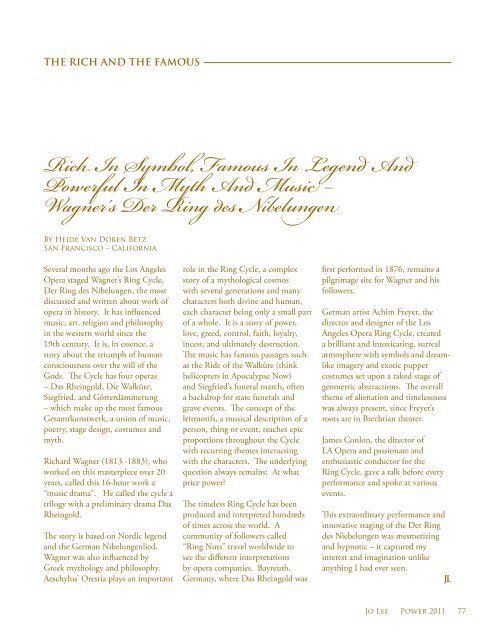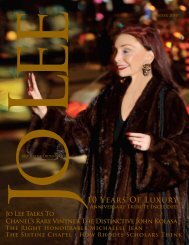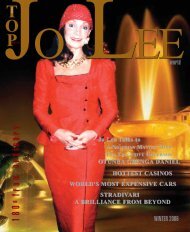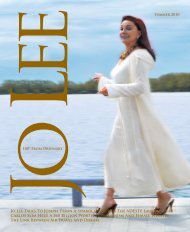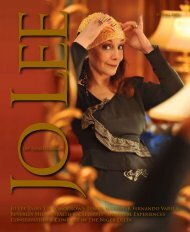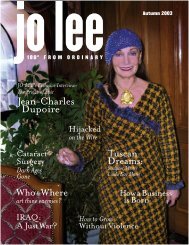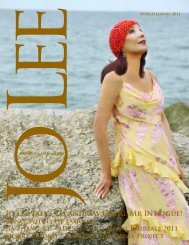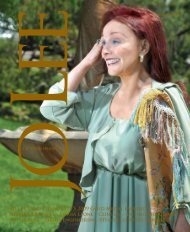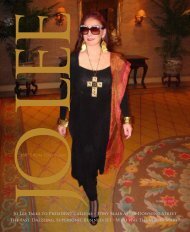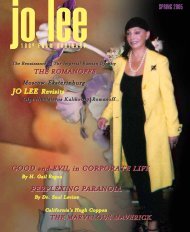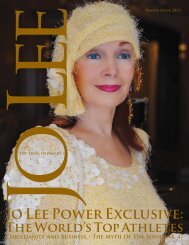Donna Saslove And Simon Lugassy - JO LEE Magazine
Donna Saslove And Simon Lugassy - JO LEE Magazine
Donna Saslove And Simon Lugassy - JO LEE Magazine
You also want an ePaper? Increase the reach of your titles
YUMPU automatically turns print PDFs into web optimized ePapers that Google loves.
THE RICH AND THE FAMOUS<br />
Rich In Symbol, Famous In Legend <strong>And</strong><br />
Powerful In Myth <strong>And</strong> Music –<br />
Wagner’s Der Ring des Nibelungen<br />
By Heide Van Doren Betz<br />
San Francisco – California<br />
Several months ago the Los Angeles<br />
Opera staged Wagner’s Ring Cycle,<br />
Der Ring des Nibelungen, the most<br />
discussed and written about work of<br />
opera in history. It has influenced<br />
music, art, religion and philosophy<br />
in the western world since the<br />
19th century. It is, in essence, a<br />
story about the triumph of human<br />
consciousness over the will of the<br />
Gods. The Cycle has four operas<br />
– Das Rheingold, Die Walküre,<br />
Siegfried, and Götterdämmerung<br />
– which make up the most famous<br />
Gesamtkunstwerk, a union of music,<br />
poetry, stage design, costumes and<br />
myth.<br />
Richard Wagner (1813 -1883), who<br />
worked on this masterpiece over 20<br />
years, called this 16-hour work a<br />
“music drama”. He called the cycle a<br />
trilogy with a preliminary drama Das<br />
Rheingold.<br />
The story is based on Nordic legend<br />
and the German Nibelungenlied.<br />
Wagner was also influenced by<br />
Greek mythology and philosophy.<br />
Aeschylus’ Orestia plays an important<br />
role in the Ring Cycle, a complex<br />
story of a mythological cosmos<br />
with several generations and many<br />
characters both divine and human,<br />
each character being only a small part<br />
of a whole. It is a story of power,<br />
love, greed, control, faith, loyalty,<br />
incest, and ultimately destruction.<br />
The music has famous passages such<br />
as the Ride of the Walküre (think<br />
helicopters in Apocalypse Now)<br />
and Siegfried’s funeral march, often<br />
a backdrop for state funerals and<br />
grave events. The concept of the<br />
leitmotifs, a musical description of a<br />
person, thing or event, reaches epic<br />
proportions throughout the Cycle<br />
with recurring themes interacting<br />
with the characters. The underlying<br />
question always remains: At what<br />
price power?<br />
The timeless Ring Cycle has been<br />
produced and interpreted hundreds<br />
of times across the world. A<br />
community of followers called<br />
“Ring Nuts” travel worldwide to<br />
see the different interpretations<br />
by opera companies. Bayreuth,<br />
Germany, where Das Rheingold was<br />
first performed in 1876, remains a<br />
pilgrimage site for Wagner and his<br />
followers.<br />
German artist Achim Freyer, the<br />
director and designer of the Los<br />
Angeles Opera Ring Cycle, created<br />
a brilliant and intoxicating, surreal<br />
atmosphere with symbols and dreamlike<br />
imagery and exotic puppet<br />
costumes set upon a raked stage of<br />
geometric abstractions. The overall<br />
theme of alienation and timelessness<br />
was always present, since Freyer’s<br />
roots are in Brechtian theater.<br />
James Conlon, the director of<br />
LA Opera and passionate and<br />
enthusiastic conductor for the<br />
Ring Cycle, gave a talk before every<br />
performance and spoke at various<br />
events.<br />
This extraordinary performance and<br />
innovative staging of the Der Ring<br />
des Niebelungen was mesmerizing<br />
and hypnotic – it captured my<br />
interest and imagination unlike<br />
anything I had ever seen.<br />
JL<br />
Jo Lee Power 2011 77


